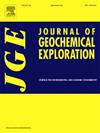通过原位矿物学分析揭示鄂尔多斯盆地北部八音青格利矿床U、Re、Se、V富集机制
IF 3.3
2区 地球科学
Q1 GEOCHEMISTRY & GEOPHYSICS
引用次数: 0
摘要
鄂尔多斯盆地北部的八音青格里铀矿床富含铀,与铼(Re)、硒(Se)、钒(V)等有价元素共富集。利用电子探针微量分析仪(EPMA)和激光烧蚀电感耦合等离子体质谱(LA-ICP-MS)对八音青格利矿床全岩地球化学及自生矿物原位分析的新资料,阐明了砂岩型铀矿床中铀及其伴生元素的富集机制。粘土矿物和黄铁矿(为分类目的简称为Py)分为两类:与铀成矿有关的(Clay1和Py1)和与铀成矿无关的(Clay2和Py2)。铼主要赋存于粘土矿物中,部分赋存于铀矿物中。硒要么以离散矿物的形式存在,如辉长石和亚铁亚铁,要么作为Py1中的晶格替代物存在。钒在未改变的U矿物和粘土中富集,可能以晶格取代形式存在。铀主要以方解石胶结的铀矿体形式赋存,表明成矿流体为碱性、富碳酸盐。coffinite与富铁蒙脱石(FeO高达14.14 wt%)(一种典型的中性环境矿物)的密切结合,以及它们对溶解的Py1的广泛替代表明,氧化还原和pH的局部突变有利于U的成矿。黄铁矿的溶蚀作用形成局部酸性还原环境,引发含矿流体析出U。八音青格利矿床受多种流体源控制。在成矿阶段,早期低温碱性氧化流体将U、Re、Se、V等氧化还原敏感元素引入氧化还原过渡带,使其富集。方解石胶结部分地保护了原生铀矿物免于氧化。在渗透性砂岩中,氧化流体的持续相互作用可使铀矿物重新活化并提取V。在成矿后阶段,矿内流体来源和性质的变化导致蚀变的方解石中Sc、Y、P含量增加,并形成低硒Py2和有机衍生方解石。深入认识砂岩含铀矿床的成矿机理及U、Re、Se、V的赋存状态,对鄂尔多斯盆地矿产勘查和资源利用具有重要意义。本文章由计算机程序翻译,如有差异,请以英文原文为准。

Unraveling the enrichment mechanisms of U, Re, Se and V in the Bayinqinggeli Deposit, Northern Ordos Basin through in situ mineralogical analysis
The Bayinqinggeli uranium (U) deposit, located in the northern Ordos Basin, is rich in U and co-enriched with valuable elements such as rhenium (Re), selenium (Se), and vanadium (V). This study presents new data of whole-rock geochemistry, as well as in situ analysis of authigenic minerals in the Bayinqinggeli deposit using Electron Probe Microanalyzer (EPMA) and Laser Ablation Inductively Coupled Plasma Mass Spectrometry (LA-ICP-MS), to elucidate the enrichment mechanisms of U and associated elements in the sandstone-hosted U deposit. The clay minerals and pyrites (abbreviated as Py for classification purposes) are each categorized into two types: those associated with U mineralization (Clay1 and Py1) and those not associated (Clay2 and Py2). Rhenium is primarily hosted within clay minerals and some in U minerals. Selenium is present either as discrete minerals such as clausthalite and ferroselite, or as a lattice substitute within Py1. Vanadium is enriched in unaltered U minerals and Clay1, likely existing as lattice substitutions. Uranium predominantly occurs as coffinite that is largely cemented by ore-stage calcite, which is indicative of an alkaline, carbonate-rich ore-forming fluid. The intimate association of coffinite with iron-rich montmorillonite (FeO up to 14.14 wt%), a typically neutral-environment mineral, and their extensive replacement for the dissolved Py1 demonstrate that localized abrupt changes in redox and pH facilitate U mineralization. The dissolution of pyrite resulted in a localized acidic and reducing environment and triggered U precipitation from the ore-bearing fluids. The Bayinqinggeli deposit was controlled by multiple sources of fluids. During the ore-forming stage, the early low-temperature alkaline oxidizing fluid introduced redox-sensitive elements, including U, Re, Se, and V, into a redox transition zone, leading to their enrichment. Calcite cementation partially preserved primary U minerals from oxidation. The persistent interaction of oxidizing fluids could remobilize U minerals and extract V in permeable sandstones. During the post-ore-forming stage, changes in the sources and nature of fluids within the deposit led to increased levels of Sc, Y, and P in altered coffinite, as well as the formation of low-Se Py2 and organically derived calcite. This profound understanding on mineralization mechanism of sandstone-hosted U deposits, and occurrence of U, Re, Se, and V, is crucial for mineral exploration and resource utilization in the Ordos Basin.
求助全文
通过发布文献求助,成功后即可免费获取论文全文。
去求助
来源期刊

Journal of Geochemical Exploration
地学-地球化学与地球物理
CiteScore
7.40
自引率
7.70%
发文量
148
审稿时长
8.1 months
期刊介绍:
Journal of Geochemical Exploration is mostly dedicated to publication of original studies in exploration and environmental geochemistry and related topics.
Contributions considered of prevalent interest for the journal include researches based on the application of innovative methods to:
define the genesis and the evolution of mineral deposits including transfer of elements in large-scale mineralized areas.
analyze complex systems at the boundaries between bio-geochemistry, metal transport and mineral accumulation.
evaluate effects of historical mining activities on the surface environment.
trace pollutant sources and define their fate and transport models in the near-surface and surface environments involving solid, fluid and aerial matrices.
assess and quantify natural and technogenic radioactivity in the environment.
determine geochemical anomalies and set baseline reference values using compositional data analysis, multivariate statistics and geo-spatial analysis.
assess the impacts of anthropogenic contamination on ecosystems and human health at local and regional scale to prioritize and classify risks through deterministic and stochastic approaches.
Papers dedicated to the presentation of newly developed methods in analytical geochemistry to be applied in the field or in laboratory are also within the topics of interest for the journal.
 求助内容:
求助内容: 应助结果提醒方式:
应助结果提醒方式:


